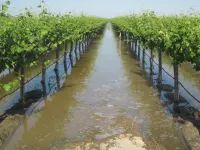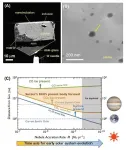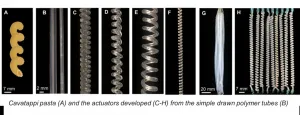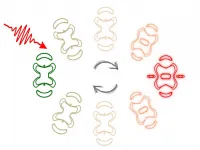(Press-News.org) Floodwaters are not what most people consider a blessing. But they could help remedy California's increasingly parched groundwater systems, according to a new Stanford-led study. The research, published in Science Advances, develops a framework to calculate future floodwater volumes under a changing climate and identifies areas where investments in California's aging water infrastructure could amplify groundwater recharge. As the state grapples with more intense storms and droughts, stowing away floodwaters would not only reduce flood risks but also build more water reserves for drier times.
"This is the first comprehensive assessment of floodwater recharge potential in California under climate change," said study lead author Xiaogang He, an assistant professor in civil and environmental engineering at the National University of Singapore who pursued the research as a postdoctoral fellow at Stanford's Program on Water in the West.
Whether it's rivers overflowing in the Central Valley flatlands, high-tide storms hitting lowland coastal areas, flash floods drenching southern deserts or impermeable concrete-laden cities pooling with water, California is susceptible to flooding. Alternately, looming droughts often raise concern about water supply, as diminished groundwater sinks land, contaminates drinking water and reduces surface supplies. These declining reserves also hamper climate resilience - during periods of drought up to 60 percent of the state's water comes from groundwater and 85 percent of Californians depend on the resource for at least a portion of their water supply.
Water banking
As climate change intensifies the severity and frequency of these extreme events, amplifying refill rates could help the state reach a more balanced groundwater budget. One practice, called water banking or managed aquifer recharge, involves augmenting surface infrastructure, such as reservoirs or pipelines, with underground infrastructure, such as aquifers and wells, to increase the transfer of floodwater for storage in groundwater basins.
A newer strategy for managing surface water, compared to more traditional methods like reservoirs and dams, water banking poses multiple benefits including flood risk reduction and improved ecosystem services. While groundwater basins offer a vast network for water safekeeping, pinpointing areas prime for replenishment, gauging infrastructure needed and the amount of water available remains key, especially in a warming and uncertain climate.
"Integrating managed aquifer recharge with floodwaters into already complex water management infrastructure offers many benefits, but requires careful consideration of uncertainties and constraints. Our growing understanding of climate change makes this an opportune time to examine the potential for these benefits," said senior author David Freyberg, an associate professor of civil and environmental engineering at Stanford.
The researchers designed a framework to estimate future floodwater availability across the state. Developing a hybrid computer model using hydrologic and climate simulations and statistical tools, the team calculated water available for recharge under different climate change scenarios through 2090. They also identified areas where infrastructure investments should be prioritized to tap floodwater potential and increase recharge.
Future floodwaters
The team found California will experience increased floodwater from both heavier rain patterns and earlier snowmelt due to warmer temperatures, under a narrowing window of concentrated wet weather. In particular, the Sacramento River and North Coast, along with the northern and central Sierra Nevada region, will see more substantial floodwater volumes. These deluges could overload current water infrastructure, such as reservoirs and aqueducts. However, if the region is standing ready with additional floodwater diversion infrastructure, such as canals or pipelines, it could maximize recharge potential and transfer more of it toward arid Southern California.
Future projections find unchanging or in some cases even drier conditions in Southern California. This widening divide is bad news for the region, which currently has greater groundwater depletion and recharge needs than its northern counterpart. This mismatch of water abundance and need reveals a profound challenge for recharge practices, in terms of moving high volumes of water from where it will be available in Northern California to where it will be needed southward.
The researchers also found recharge estimates for the San Joaquin Valley - one of the world's most productive agricultural regions - could help restock a large portion of depleted groundwater aquifers. Sitting at the base of the Sierra Nevada mountains, this region will need to accommodate larger volumes of water both above and below the surface in order to maximize refill potential. Water managers will need to expand conveyance projects and reopen reservoirs there.
While climate impacts are the most dominant influence, the researchers point out that other factors, including infrastructure capacity, policy constraints, financial and environmental concerns must be jointly considered during the planning process.
The study's framework is adaptable and scalable for managing drought, flood and depleted groundwater aquifers worldwide.
"At the global scale only 1 percent of groundwater recharge occurs from managed aquifer recharge," He said. "This work can be applied to help other depleted aquifers, such as the North China Plain or India's Upper Ganges, reach and maintain sustainable groundwater levels."
INFORMATION:
David Freyberg is also a senior fellow at the Stanford Woods Institute for the Environment. Additional authors are Benjamin P. Bryant, WitW research collaborator currently based at Millennium Challenge Corporation; Tara Moran, WitW research collaborator and California Water Data Consortium president; Katharine J. Mach, associate professor, University of Miami; and Zhongwang Wei, associate professor, Sun Yat-Sen University.
Addressing a much-debated question about the impact of stress on survival in wild, nonhuman primates, a new multi-decadal study involving 242 wild female baboons found evidence to support chronic stress as a significant factor affecting survival. The study found that a female baboon with a stress response - as reflected in fecal glucocorticoid concentrations, a biomarker of stress response - in the top 90% for her age throughout adulthood was expected to lose 5.4 years of life compared to a female with glucocorticoid concentrations in the bottom 10% for her age group. The findings, which leveraged more than 14,000 fecal glucocorticoid measurements over a ...
MADISON, Wis. -- Tens of millions of people worldwide are affected by diseases like macular degeneration or have had accidents that permanently damage the light-sensitive photoreceptors within their retinas that enable vision.
The human body is not capable of regenerating those photoreceptors, but new advances by medical researchers and engineers at the University of Wisconsin-Madison may provide hope for those suffering from vision loss. They described their work today in the journal Science Advances.
Researchers at UW-Madison have made new photoreceptors from human pluripotent stem cells. However, it remains challenging to precisely deliver those photoreceptors within the diseased or damaged eye so that ...
Water is abundant in our solar system. Even outside of our own planet, scientists have detected ice on the moon, in Saturn's rings and in comets, liquid water on Mars and under the surface of Saturn's moon Enceladus, and traces of water vapor in the scorching atmosphere of Venus. Studies have shown that water played an important role in the early evolution and formation of the solar system. To learn more about this role, planetary scientists have searched for evidence of liquid water in extraterrestrial materials such as meteorites, most of which originate from asteroids that formed in the early history of the solar system.
Scientists have even found water as hydroxyls and molecules in meteorites in the context ...
Two of the COVID-19 vaccines currently approved in the United States require two doses, administered three to four weeks apart, however, there are few data indicating how best to minimize new infections and hospitalizations with limited vaccine supply and distribution capacity. A study published on 21st April, 2021 in the open access journal PLOS Biology by Seyed Moghadas at York University in Toronto, Canada, and colleagues suggests that delaying the second dose could improve the effectiveness of vaccine programs.
The emergence of novel, more contagious SARS-CoV-2 variants has led to a public health debate on whether to vaccinate more individuals with the first ...
Swing voters in battleground states delivered Donald Trump his unexpected victory in the 2016 presidential election, suggests a new study coauthored by Yale political scientist Gregory A. Huber.
The study, published on April 21 in the journal Science Advances, compares the outcomes of the 2012 and 2016 presidential elections in six key states: Florida, Georgia, Michigan, Nevada, Ohio, and Pennsylvania. The analysis merged voter turnout records of 37 million individuals with precinct-level election returns to determine the sources of Trump's electoral success. It examined the relative roles of conversion -- voters switching their support from one party to the ...
Boston, MA - In a worldwide survey, pregnant and postpartum women reported high levels of depression, anxiety, loneliness, and post-traumatic stress during the COVID-19 pandemic, according to researchers at Harvard T.H. Chan School of Public Health. Such high levels of distress may have potential implications for women and for fetal and child health and development, according to the study.
The study will be published online in PLOS ONE on April 21, 2021.
"We expected to see an increase in the proportion of pregnant and postpartum women reporting mental health distress, as they are likely to be worried or have questions about their babies' health and development, ...
In the field of robotics, researchers are continually looking for the fastest, strongest, most efficient and lowest-cost ways to actuate, or enable, robots to make the movements needed to carry out their intended functions.
The quest for new and better actuation technologies and 'soft' robotics is often based on principles of biomimetics, in which machine components are designed to mimic the movement of human muscles--and ideally, to outperform them. Despite the performance of actuators like electric motors and hydraulic pistons, their rigid form limits how they can be deployed. As robots transition to more ...
Researchers of the University of Barcelona, together with researchers from the University of Zurich (Switzerland) and Brown University (United States), have analysed more than 10,000 evaluations that were carried out to candidates who wish to hold a public teaching permanent in Catalonia. The objective was to study how the decision by the committee of evaluators is affected by the fact that each candidate holds a certain position in the lists of people to be assessed. The study, published in the journal Science Advances, identifies a new cognitive bias that researchers have named "generosity-erosion effect". It involves that once the evaluators have scored one candidate generously, ...
Brandi Wren was studying social distancing and infections before masking tape marks appeared on the grocery store floor and plastic barriers went up in the post office.
Wren, a visiting scholar in the Department of Anthropology at Purdue University, spent a year studying wild vervet monkey troops in South Africa, tracking both their social grooming behavior and their parasite load. Her results, some of which were published Wednesday (April 21) in PLOS ONE showed evidence that monkeys carrying certain gastrointestinal parasites do not groom others as much as those without the parasite, and that routes of transmission may not be as clear cut as biologists think.
With implications for both animal behavior and human health, Wren's results open new avenues for research and ...
Making the speed of electronic technology as fast as possible is a central aim of contemporary materials research. The key components of fast computing technologies are transistors: switching devices that turn electrical currents on and off very quickly as basic steps of logic operations. In order to improve our knowledge about ideal transistor materials, physicists are constantly trying to determine new methods to accomplish such extremely fast switches. Researchers from the Fritz Haber Institute of the Max Planck Society in Berlin and the Max Planck Institute for the Structure and Dynamics of Matter in Hamburg have now figured out ...






